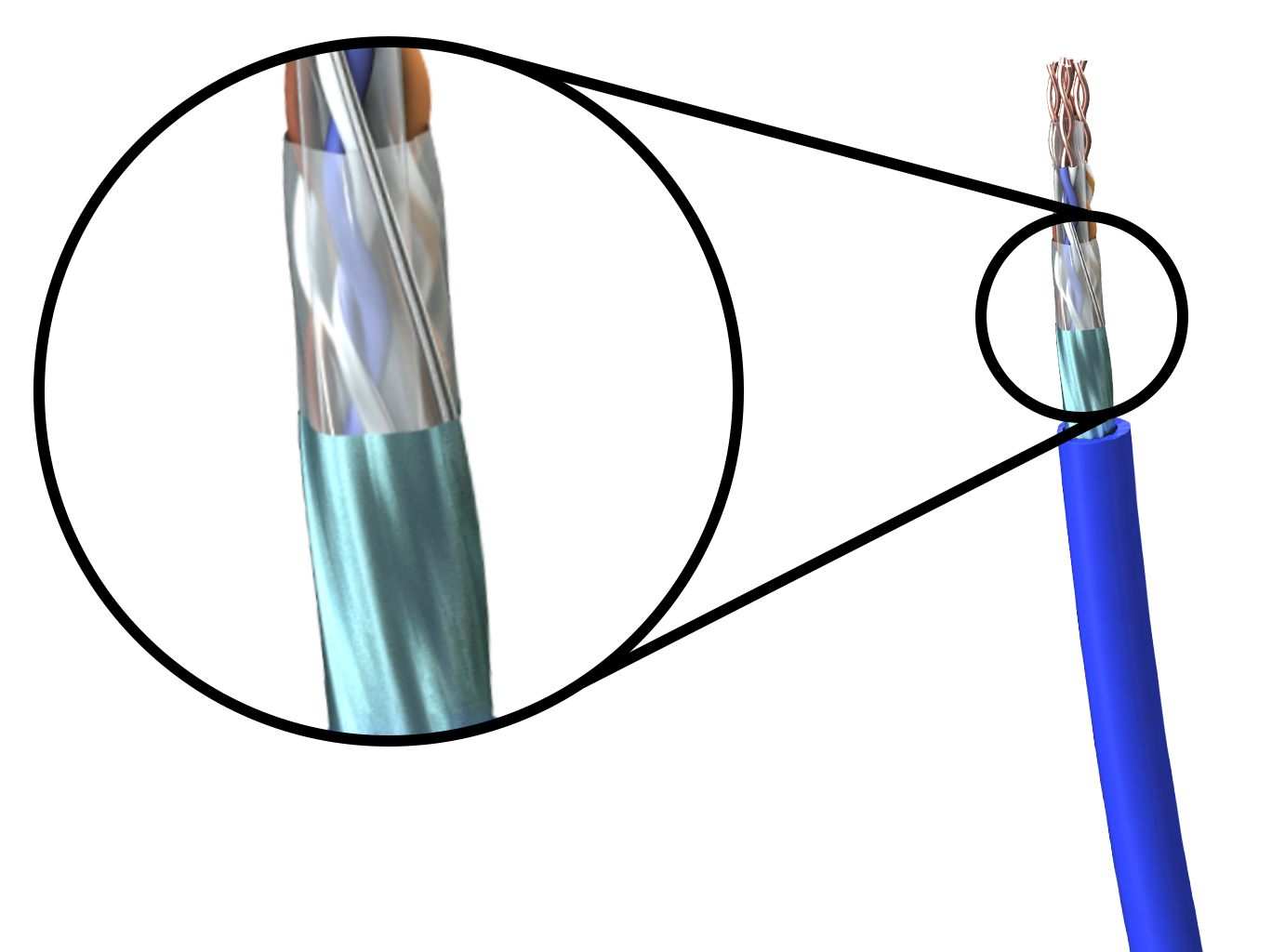Posted 27 April 2022
This article looks at the role of Ethernet data cables, how they are designed, and how, today, they are available in several different categories. This should help you in deciding which data cable category (or categories) is/are best for your particular application.
While wireless networking standards such as WiFi have become ubiquitous, hardwired networking still has an important role. It offers high data rates with good reliability and security, and an ability to circumvent obstacles – and the most common hardwired network standard today is Ethernet.
The IEEE 802.3 Ethernet standard
The Ethernet standard was first developed by the Xerox Corporation as an experimental coaxial cable based system in the 1970s. Using a Carrier Sense Multiple Access / Collision Detect (CSMA/CD) protocol to allow multiple clients, it was intended for use with LANs that were likely to experience mostly sporadic but occasionally heavy activity.
The success of the original Ethernet project led to a joint development of a 10mbps standard in 1980. This time three companies were involved: Digital Equipment Corporation, Intel, and Xerox.
The Ethernet Version 1 specification that arose from this development formed the basis for the first Institute of Electrical and Electronics Engineers IEEE 802.3 standard for local area networks or LANs, which was approved in 1983, and finally published as an official standard in 1985.
Since then, the IEEE 802.3 standard has continued to evolve to accommodate newer technologies, and is still in use today. It has two main elements: network nodes, and interconnecting media.
Network nodes are the items which process the data which is communicated over the ethernet cable network. These nodes are either computers, or routing elements such as switchers, routers, and hubs. A system can also have other miscellaneous devices such as printers and security cameras which also need network access.

Interconnecting media refers to cables, which can be coaxial, fibre optic, or twisted pair. Coaxial was one of the first types to be used for Ethernet, but is seldom deployed now as it is expensive and difficult to install. Fibre optic is becoming increasingly popular as it provides very good noise immunity and supports very high data rates. Twisted pair is now the normal solution for copper ethernet cables, and is available in either Unshielded Twisted Pair (UTP) or Shielded Twisted Pair (STP) format. STP's comprise of a twisted cable pair enclosed in a foil or braid shield.
The choice of UTP vs STP depends on individual circumstances and priorities, as a number of factors are involved. UTP cables are smaller, lighter, more flexible, lower cost, and easier to install than STP types. Additionally, UTPs, unlike STPs, do not require a grounding cable. However, STPs are less susceptible to noise and crosstalk, and provide higher data rates.
Twisted pair ethernet cables vary in length, usually from around 0.3 metres to 30 metres or more. Cables can also be cut to length. They are normally terminated with Registered Jack (RJ45) connectors, although transition arrangements may be necessary for modern laptop computers too slim to accommodate an RJ45 socket. Ethernet cables are also available in a variety of colours – these colours do not represent any difference in technical specification, but instead are provided as an aid to ease management and maintenance of networks.
Telecommunications Industry Association standard ANSI/TIA 568 C.2 and cable categories
When it comes to choosing the right cables for your network installation, you can be guided by Categories as defined by the Telecommunications Industry Association standard ANSI/TIA 568 C.2.
This standard is meant to eliminate misunderstandings between manufacturers and purchasers, facilitate interchangeability and product improvement and to help you select the proper product for your needs.
The standard covers both mandatory and advisory criteria. The mandatory criteria specify the minimum acceptable requirements that apply to protection, performance, administration, and compatibility. The advisory criteria present factors that will enhance the performance of the cabling system.
The first cable category to be specified was Category 1 (Cat 1), which could carry a 10kHz signal and deliver 1Mps of data. However, Cat 1 cables are no longer in use. Similarly, Cats 2 and 4 are obsolete, and Cat 5 is nearly if not entirely so. Accordingly, the ANSI/TIA 568 C.2. standard covers Cat3, Cat 5e (enhanced), Cat 6 and Cat 6a (augmented) cabling and components. All these cables are 100Ω balanced twisted-pair types.
Because Cat numbers have incremented over the years as improving technology has been adopted, higher Cat numbers mean higher performance.
Cat 3 supports transmission at up to 16MHz, with a data rate of up to 10 Mbps. In spite of its limited performance, it remains popular for some applications such as PBX phone systems and Voice over Internet Protocol (VoIP) applications due to its low cost.
Cat 5E is popular for mainstream network installations. With a 100MHz performance, it supports data rates of up to 1 Gbps, and can carry power for Power Over Ethernet applications.
Cat 6 and 6a (augmented) cables are used in both office and home networks. They are backward compatible with Cat5/5e, but have higher performance and improved resistance to crosstalk and system noise. Cat 6 runs at 250MHz and is rated at up to 10Gbps for distances of up to 55 metres; for greater distances, up to 100 metres, use Cat 6a, which performs at 500MHz.
Cables of newer categories can operate in systems also containing older-category cables, but overall system performance will be limited to that of the slowest system component.
The ANSI/TIA 568 C.2. standard also covers mechanical requirements. It specifies that the performance can only be achieved with the use of compliant components. Each category of cable must consist of four twisted pairs with solid or stranded conductors sized between 22AWG and 24AWG with thermoplastic insulation and an overall thermoplastic jacket with a diameter less than or equal to 9.0mm. It also defines a set of mechanical performance requirements, testing and test methods that the cables must comply with, as well as colour codes for the cables’ internal conductors, and two standard pinouts – T568A and the more popular T568B.
Finally, the standard covers transmission requirements such as Return Loss, Insertion Loss, Near End Crosstalk Loss (NEXT) and many others.
There are two further categories, which, however, are not recognised by the Telecommunications Industry Association: Cat 7 and Cat 8.

Category 7 cable debuted in 2010 and is aimed at data centres and server rooms where top speed counts. Each cable is double-shielded: around each pair of wires and an overall shield around the entire bundle of wires. This extra isolation is needed because the 600MHz frequency used can deliver a maximum of 10Gbps over 330 feet. More recently, the introduction of Cat 7A cable increases the speed to 1GHz and throughput to 40Gbps, but at a maximum distance of 165 feet.
Cat 8 cable is available for top-end data centre applications. It can support 1 or 2GHz with data rates to 40Gbps. It require double-shielding, metal-jacketed connectors and is limited to runs of 100 feet.
Conclusion
In shopping for network data cables, cost is always going to be important – but the immediate purchase price is not the only issue. The remedial costs of replacing a structured cable installation that proves to be inadequate in terms of noise immunity or performance would far outweigh any savings on lower-cost, reduced quality cables.
It is well worth discussing your cabling requirements with experienced, reputable specialists like FS Cables. We can ensure that you identify the right cable for the job, and will deliver products that are fully-compliant with their stated specifications.
References:
https://www.electronics-notes.com/articles/connectivity/ethernet-ieee-802-3/basics-tutorial.php
https://www.cablestogo.com/learning/library/standards-specs-certs/ansi-tia
https://www.techwalla.com/articles/cat-3-vs-cat-5-cable
https://www.tomsguide.com/uk/reference/ethernet-cables-explained
https://www.cablestogo.com/learning/library/standards-specs-certs/ansi-tia
https://www.techwalla.com/articles/cat-3-vs-cat-5-cable
https://www.tomsguide.com/uk/reference/ethernet-cables-explained





